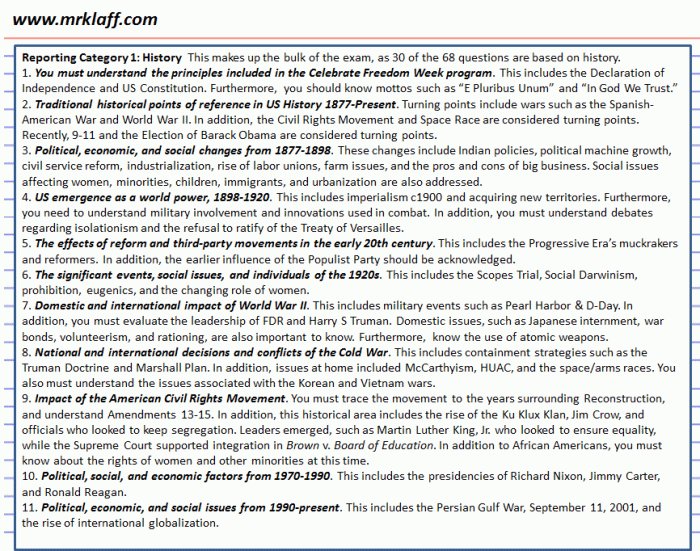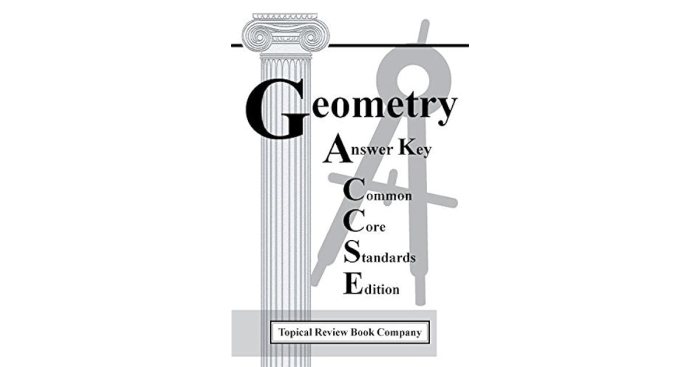Us history staar study guide – Prepare to conquer the US History STAAR exam with our comprehensive study guide. Embark on a journey through time, where historical events, key figures, and social movements come alive, guiding you towards a stellar performance.
Our guide unveils the intricate tapestry of American history, empowering you with the knowledge and confidence to excel on the exam.
Historical Periods and Eras

The rich tapestry of US history is woven from a multitude of distinct periods and eras, each marked by unique characteristics, defining events, and profound significance.
From the tumultuous birth of a nation during the American Revolution to the transformative crucible of the Civil War and the economic upheaval of the Great Depression, these historical epochs have shaped the very fabric of the American experience.
American Revolution (1775-1783)
The American Revolution, a pivotal moment in US history, erupted from the escalating tensions between the British Crown and its American colonies. The war, fought from 1775 to 1783, culminated in the Declaration of Independence in 1776, a bold assertion of American self-determination that reverberated throughout the world.
- Causes: British colonial policies, taxation without representation, and the desire for self-governance.
- Consequences: The birth of the United States, the establishment of a republican form of government, and the weakening of European colonial powers.
Civil War (1861-1865)
The Civil War, a profound and divisive conflict, tore the nation apart from 1861 to 1865. The war, fought primarily over the issue of slavery, resulted in the abolition of the institution and the preservation of the Union.
- Causes: Slavery, states’ rights, and the growing economic and political divide between the North and South.
- Consequences: The end of slavery, the strengthening of the federal government, and the Reconstruction era, which aimed to rebuild the war-torn nation.
Great Depression (1929-1939)
The Great Depression, a global economic catastrophe, began with the stock market crash of 1929. The depression, which lasted for a decade, brought widespread unemployment, poverty, and social unrest.
- Causes: Overspeculation in the stock market, unregulated banking practices, and the collapse of international trade.
- Consequences: Economic devastation, the rise of authoritarian regimes, and the implementation of the New Deal, a series of government programs designed to stimulate the economy.
Key Figures and Events

The tapestry of US history is intricately woven with the threads of influential figures and momentous events. From the visionary minds who shaped the nation’s founding principles to the heroes who fought for its preservation and expansion, these individuals and occurrences have left an enduring mark on the American narrative.
Pivotal events, such as the signing of the Declaration of Independence, the Battle of Gettysburg, and the Apollo 11 moon landing, have shaped the course of the nation, forever altering its destiny.
Key Historical Figures
Throughout history, countless individuals have played pivotal roles in shaping the United States. Here are a few notable figures:
- George Washington: The “Father of the Nation,” led the Continental Army to victory in the American Revolutionary War and served as the first President of the United States.
- Abraham Lincoln: The 16th President, guided the nation through the Civil War and issued the Emancipation Proclamation, abolishing slavery.
- Martin Luther King Jr.: A civil rights leader, fought for racial equality and nonviolent resistance during the Civil Rights Movement.
- Rosa Parks: An African-American woman, sparked the Montgomery Bus Boycott with her refusal to give up her seat on a bus, leading to the desegregation of public transportation.
- Neil Armstrong: An astronaut, became the first human to walk on the moon during the Apollo 11 mission.
Pivotal Events, Us history staar study guide
Significant events have shaped the trajectory of US history, leaving lasting legacies:
- Signing of the Declaration of Independence (1776): Declared the 13 American colonies’ independence from British rule, marking the birth of the United States.
- Battle of Gettysburg (1863): A turning point in the Civil War, resulting in a Union victory and weakening the Confederacy.
- Apollo 11 Moon Landing (1969): A triumph of human ingenuity, with Neil Armstrong and Buzz Aldrin becoming the first humans to walk on the moon.
Social and Cultural Movements: Us History Staar Study Guide
Social and cultural movements have been a driving force in shaping the history and fabric of American society. These movements have fought for justice, equality, and progress, leaving a lasting impact on the nation’s laws, culture, and social norms.
One of the most significant social movements in US history was the abolitionist movement, which fought to end slavery. Key events in this movement include the publication of Harriet Beecher Stowe’s influential novel “Uncle Tom’s Cabin,” the formation of the American Anti-Slavery Society, and the outbreak of the Civil War.
The movement ultimately succeeded in abolishing slavery through the passage of the 13th Amendment to the Constitution.
While studying for the US History STAAR exam, you may want to try out a different practice test. The Unit 1 AP Euro practice test has a similar format and difficulty level, so it can be a helpful way to assess your knowledge.
After taking the AP Euro practice test, you can return to your US History STAAR study guide to reinforce the concepts you’ve reviewed.
Women’s Suffrage Movement
The women’s suffrage movement fought for the right of women to vote. Key figures in this movement include Susan B. Anthony, Elizabeth Cady Stanton, and Alice Paul. The movement’s efforts culminated in the passage of the 19th Amendment to the Constitution, which granted women the right to vote.
Civil Rights Movement
The civil rights movement fought for the equality of African Americans and the end of segregation and discrimination. Key figures in this movement include Martin Luther King Jr., Rosa Parks, and Malcolm X. The movement’s efforts led to the passage of the Civil Rights Act of 1964 and the Voting Rights Act of 1965, which outlawed segregation and discrimination.
Political and Economic Developments
The evolution of the US political and economic systems has been a complex and dynamic process, shaped by a variety of factors, including the nation’s founding principles, the growth of industrialization, and the challenges of social and economic change.
Political Developments
The US political system has evolved from a loose confederation of states under the Articles of Confederation to a strong federal government under the Constitution. The development of political parties, the role of the presidency, and the balance of power between the different branches of government have all played a significant role in shaping the political landscape of the United States.
- Political Parties:The first political parties in the United States emerged in the late 18th century, with the Federalists and Democratic-Republicans representing different visions for the nation’s future. Over time, a two-party system has become the norm, with the Republican and Democratic parties dominating American politics.
- The Presidency:The presidency has evolved from a relatively weak office under the Articles of Confederation to a powerful institution under the Constitution. The president is the head of state, commander-in-chief of the armed forces, and has the power to veto legislation passed by Congress.
- Balance of Power:The US Constitution establishes a system of checks and balances designed to prevent any one branch of government from becoming too powerful. The three branches of government—legislative, executive, and judicial—each have their own powers and responsibilities, and they must work together to pass laws and govern the country.
Economic Developments
The US economy has undergone a series of major transformations, from an agrarian society to an industrial powerhouse to a global economic leader. The rise of industrialization, the Great Depression, and the post-World War II economic boom have all had a profound impact on the economic development of the United States.
- Industrialization:The Industrial Revolution began in the United States in the early 19th century, leading to a rapid expansion of manufacturing and transportation. The growth of factories and the development of new technologies transformed the American economy and society.
- The Great Depression:The Great Depression, which began in 1929, was the worst economic downturn in American history. It led to widespread unemployment, poverty, and social unrest. The Great Depression had a lasting impact on the US economy and led to the New Deal, a series of government programs designed to stimulate economic recovery.
- Post-World War II Economic Boom:After World War II, the US economy experienced a period of rapid growth and prosperity. The expansion of suburbs, the growth of consumer spending, and the development of new technologies all contributed to the post-World War II economic boom.
Foreign Policy and International Relations
The United States has played a significant role in shaping global affairs since its inception. Its foreign policy decisions and diplomatic initiatives have had a profound impact on the world stage, involving major wars, alliances, and international organizations.
The motivations behind US foreign policy have been complex and varied, ranging from national security concerns to economic interests and humanitarian principles. Over the years, the US has pursued a range of diplomatic strategies, from isolationism to interventionism, seeking to protect its interests and promote its values.
Key Foreign Policy Decisions
- Monroe Doctrine (1823):Declared the Americas off-limits to European colonization, establishing US dominance in the Western Hemisphere.
- Open Door Policy (1899-1900):Advocated for equal economic opportunities for all nations in China, aimed at preserving US commercial interests.
- Lend-Lease Act (1941):Provided military aid to Allied powers during World War II, solidifying US involvement in the conflict.
- Truman Doctrine (1947):Pledged US support to countries threatened by communism, marking the beginning of the Cold War.
- Vietnam War (1954-1975):A major military conflict that tested US resolve and led to a reassessment of its foreign policy approach.
- War on Terror (2001-present):A global campaign launched after the 9/11 attacks, aimed at combating terrorism and promoting democracy.
International Organizations
- United Nations (UN):A global organization founded in 1945 to promote international cooperation and prevent war.
- North Atlantic Treaty Organization (NATO):A military alliance established in 1949 to protect against Soviet aggression.
- World Bank:An international financial institution that provides loans and grants to developing countries.
- International Monetary Fund (IMF):An international organization that promotes monetary cooperation and financial stability.
Challenges and Successes
US foreign policy has faced numerous challenges, including: rising nationalism, economic competition, and the threat of terrorism. However, it has also achieved significant successes, such as:
- Preventing the spread of communism during the Cold War.
- Promoting economic growth and development through international organizations.
- Providing humanitarian aid and disaster relief around the world.
Geographic and Environmental Factors
The United States has been shaped profoundly by its geography and environment. The vast natural resources, diverse climate zones, and transportation routes have all played a pivotal role in the nation’s development.
The abundance of natural resources, such as timber, minerals, and fertile land, provided the foundation for economic growth and industrialization. The country’s vast size and diverse climate allowed for the cultivation of a wide range of agricultural products, contributing to the nation’s food security and economic prosperity.
Environmental Challenges
The United States has also faced significant environmental challenges throughout its history. Deforestation, pollution, and climate change have all posed threats to the nation’s natural resources and human health. In response, the US has implemented various environmental regulations and conservation efforts to address these challenges.
- Deforestation:The clearing of forests for agriculture, urbanization, and logging has led to habitat loss, soil erosion, and biodiversity decline. Conservation efforts, such as reforestation and sustainable forestry practices, have been implemented to mitigate these impacts.
- Pollution:Industrialization and urbanization have resulted in air, water, and soil pollution. Environmental regulations, such as the Clean Air Act and Clean Water Act, have been enacted to control emissions and protect the environment.
- Climate Change:The United States is experiencing the effects of climate change, including rising sea levels, increased frequency and intensity of extreme weather events, and changes in agricultural productivity. Mitigation and adaptation strategies, such as reducing greenhouse gas emissions and investing in renewable energy, are being pursued to address these challenges.
FAQ Explained
What is the scope of the US History STAAR exam?
The exam covers all major historical periods and eras in US history, from the colonial era to the present day.
How can I effectively prepare for the exam using this study guide?
Review the guide thoroughly, focusing on key events, figures, and movements. Utilize the provided resources and practice questions to reinforce your understanding.
What are some tips for answering STAAR exam questions?
Read instructions carefully, manage your time wisely, and support your answers with specific evidence from the provided sources.
